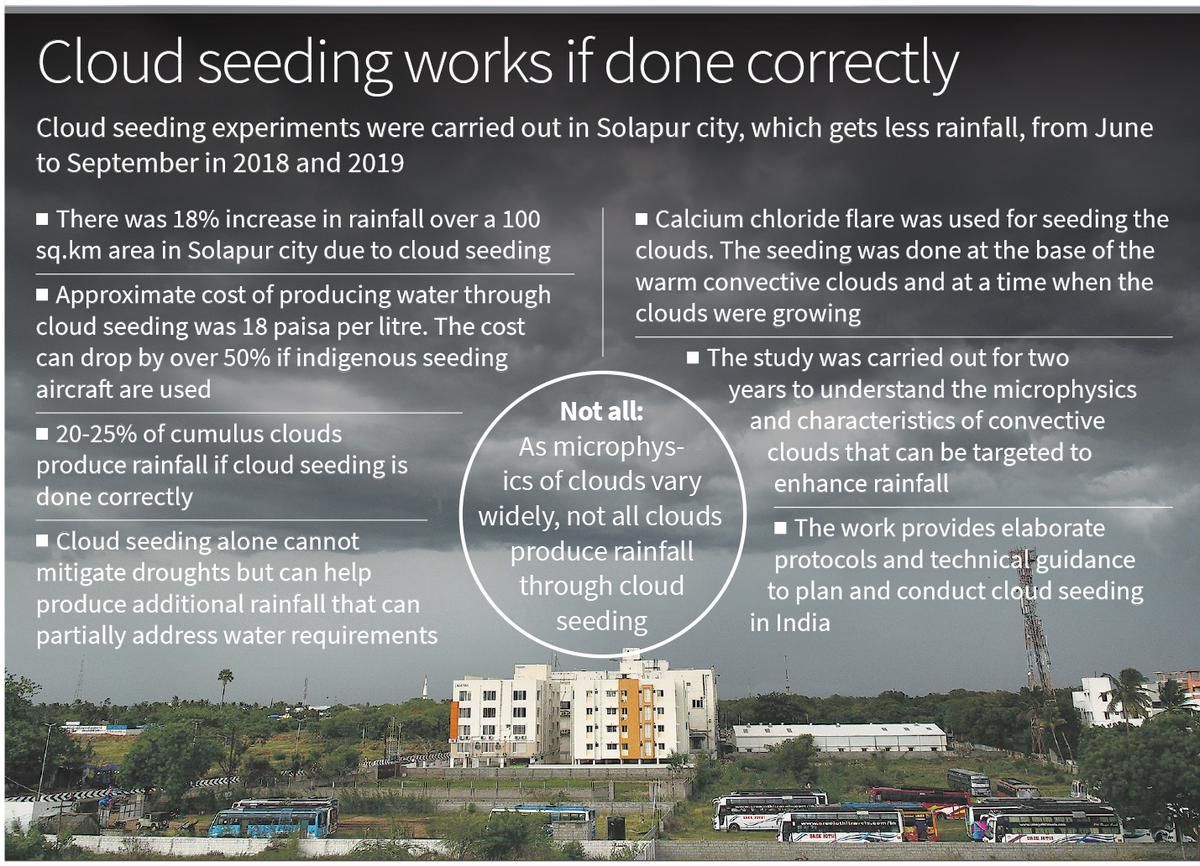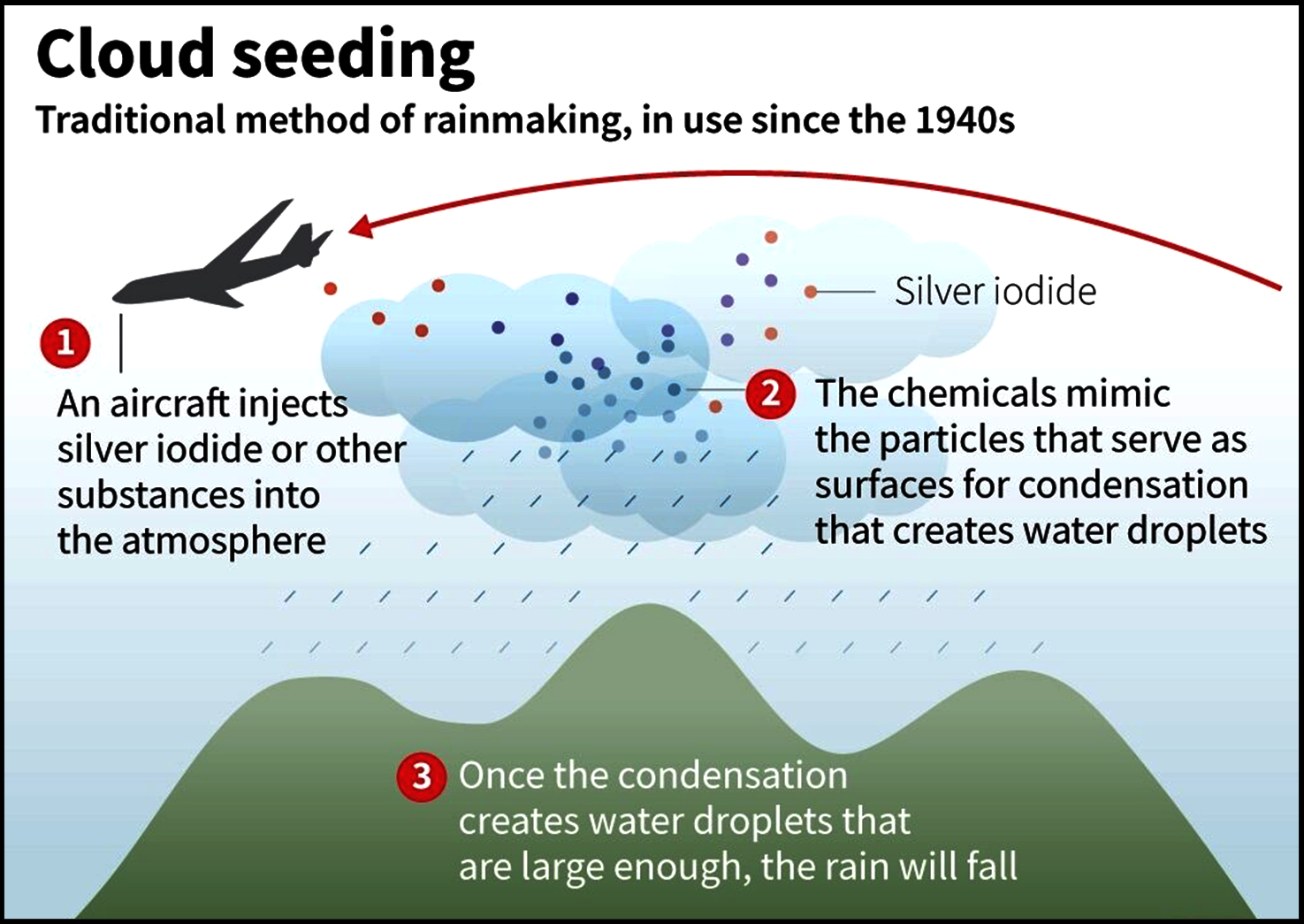Science & Technology
Cloud Seeding
- 30 Oct 2023
- 7 min read
For Prelims: Cloud Seeding and Types, Artificial Rain, Convective Clouds
For Mains: Application of Cloud Seeding and Concerns, Atmospheric Circulation, Water Resources
Why in News?
Cloud seeding, a groundbreaking technique to enhance rainfall, has taken centre stage in a recent study published in the journal Bulletin of the American Meteorological Society, conducted by the Indian Institute of Tropical Meteorology, Pune.
- The study unveils the potential of cloud seeding to boost precipitation in water-scarce regions, offering hope for tackling drought conditions.
What are the Key Highlights of the Study?
- CAIPEEX Phase-4 Investigation:
- The Cloud Aerosol Interaction and Precipitation Enhancement Experiment (CAIPEEX phase-4) was a two-year study in Solapur (Maharashtra), conducted during the 2018 and 2019 summer monsoons.
- Its primary objective was to assess the effectiveness of hygroscopic seeding in deep convective clouds and develop a cloud seeding protocol.
- Researchers used calcium chloride flares for cloud seeding.
- A cloud seeding flare releases these particles when triggered. The seeding was done at the base of the warm convective clouds and at a time when the clouds were in their growing stage so that the seed particles could enter the clouds with minimum dispersion.
- Researchers used calcium chloride flares for cloud seeding.
- The experiment employed two aircraft for cloud parameter study and cloud seeding.
- Cloud Seeding's Effectiveness:
- Cloud seeding is proven effective for enhancing rainfall under suitable conditions.
- A random seeding experiment selected 276 convective clouds, with 150 clouds subjected to seeding and 122 unseeded.
- Specific cloud characteristics, including liquid water content and vertical motion, were used to identify clouds with potential for rainfall.
- Targeted convective clouds were typically over one kilometer deep and likely to evolve into deep cumulus clouds.
- Benefits:
- Cost-Benefit Ratio:
- The approximate cost of producing water through cloud seeding was 18 paisa per liter during the research experiment.
- Using indigenous seeding aircraft could reduce costs by more than 50%.
- Managing Drought Conditions:
- Cloud seeding alone cannot fully mitigate droughts but can contribute to an 18% increase in rainfall, partially addressing water requirements.
- Undertaking cloud seeding as part of catchment-scale projects could help in drought management.
- Practical Applications:
- Cloud seeding can significantly benefit regions like Solapur which falls on the leeward side of the Western Ghats and hence gets low rainfall.
- Additional water through cloud seeding has the potential to alleviate water scarcity issues in such areas.
- Cost-Benefit Ratio:
- Microphysics and Cloud Characteristics:
- The two-year study aimed to understand the microphysics and characteristics of convective clouds suitable for enhancing rainfall.
- It provides comprehensive protocols and technical guidance for planning and conducting cloud seeding in India.
- The two-year study aimed to understand the microphysics and characteristics of convective clouds suitable for enhancing rainfall.
- Cloud Variability:
- Not all cumulus clouds respond to cloud seeding; approximately 20-25% can produce rainfall if seeding is executed correctly.
- Cloud microphysics varies widely, leading to varied results with cloud seeding.
Convective Clouds
- Convective clouds are clouds that form when warm, humid air rises through cooler air in the atmosphere.
- The warm air is less dense than the surrounding air, so it rises. This process is called convection.
- Convective clouds are also known as cumuliform clouds. They look like stacks of cotton balls.
- There are two types of convective clouds: Cumulus clouds and cumulonimbus clouds.
- Cumulus clouds are fluffy, white clouds with a flat base and a rounded top. Cumulus clouds can develop into cumulonimbus clouds, which are associated with thunderstorms.
- Cirrocumulus Clouds are high-altitude clouds that appear as small, white, and fluffy cloud patches. They often have a wavy or honeycomb-like pattern.
What is Cloud Seeding?
- About:
- It is the process of artificially generating rain by implanting clouds with particles such as silver iodide crystals.
- Cloud seeding uses planes to spray clouds with chemicals to condense smaller particles into larger rain droplets.
- Cloud Seeding Methods:
- Static Cloud Seeding:
- This method involves introducing ice nuclei, such as silver iodide or dry ice, into cold clouds that have supercooled liquid water droplets.
- The ice nuclei can trigger the formation of ice crystals or snowflakes, which can grow at the expense of the liquid droplets and fall as precipitation.
- Dynamic Cloud Seeding:
- Dynamic cloud seeding is a method of inducing rain by boosting vertical air currents.
- The process is considered more complex than static cloud seeding because it depends on a sequence of events working properly.
- Dynamic cloud seeding is a method of inducing rain by boosting vertical air currents.
- Hygroscopic Cloud Seeding:
- This method involves spraying fine particles of hygroscopic materials, such as salts through flares or explosives into the base of warm clouds.
- The particles can act as cloud condensation nuclei and increase the number and size of the cloud droplets, which can enhance the reflectivity and stability of the clouds.
- Static Cloud Seeding:
- Applications:
- Cloud seeding is done to enhance winter snowfall and increase mountain snowpack, which can supplement the natural water supply for communities in the surrounding area.
- Cloud seeding can also be done to prevent hailstorms, dissipate fog, induce rainfall in drought-prone regions, or reduce air pollution.
- Challenges:
- Cloud seeding requires the presence of moisture-filled clouds, which are not always available or predictable.
- Cloud seeding does not occur during times when additional precipitation would be problematic, such as times of high flood risk or busy holiday travel periods.
- Cloud seeding may have negative effects on the environment and health, such as altering the natural water cycle, contaminating the soil and water with chemicals, or affecting the local climate.






